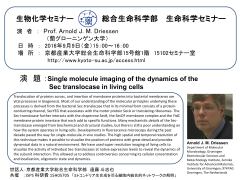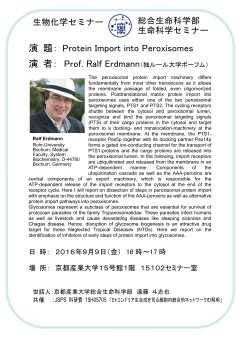総合生命科学部 生命科学セミナー開催(9月9日)
2016.07.31
生物化学セミナー/総合生命科学部 生命科学セミナー
第1部:Prof. Arnold J. M. Driessen(University of Groningen)
「Single molecule imaging of the dynamics of the Sec translocase in living cells」
Translocation of proteins across, and insertion of membrane proteins into bacterial membranes are vital processes in biogenesis. Most of our understanding of the molecular principles underlying these processes is derived from the bacterial Sec-translocase that in its minimal form consists of a protein-conducting channel, SecYEG that associates with the motor protein SecA or translating ribosomes. The Sec-translocase further interacts with the chaperone SecB, the SecDF membrane complex and the YidC membrane protein insertase that each add to specific functions. Many mechanistic details of the Sec-translocase emerged from biochemical and structural studies, but there is still a poor understanding on how the system operates in living cells. Developments in fluorescence microscopy during the past decade paved the way for single-molecule in vivo studies. The high spatial and temporal resolution of this technique makes it possible to visualize the position of proteins with great detail and provides dynamical data in a natural environment. We have used super resolution imaging of living cells to visualize the activity of individual Sec-translocases at native expression levels to reveal the dynamics of the subunit interaction. This allowed us to address controversies concerning its cellular concentration and localization, oligomeric state and dynamics.
第2部:Prof. Ralf Erdmann(Ruhr-University Bochum)
「Protein Import into Peroxisomes」
The peroxisomal protein import machinery differs fundamentally from most other translocons as it allows the membrane passage of folded, even oligomerized proteins. Posttranslational matrix protein import into peroxisomes uses either one of the two peroxisomal targeting signals, PTS1 and PTS2. The cycling receptors shuttle between the cytosol and peroxisomal lumen, recognize and bind the peroxisomal targeting signals (PTS) of their cargo proteins in the cytosol and target them to a docking- and translocation-machinery at the peroxisomal membrane. At the membrane, the PTS1- receptor Pex5p together with its docking partner Pex14p forms a gated ion-conducting channel for the transport of PTS1-proteins and the cargo proteins are released into the peroxisomal lumen. In the following, import receptors are ubiquitinated and released from the membrane in an ATP-dependent manner. Components of the ubiquitination cascade as well as the AAA-peroxins are central components of an export machinery, which is responsible for the ATP-dependent release of the import receptors to the cytosol at the end of the receptor cycle. Here I will report on dissection of steps in peroxisomal protein import with emphasis on the structure and function of the AAA-peroxins as well as alternative protein import pathways into peroxisomes.
Glycosomes represent a subclass of peroxisomes that are essential for survival of protozoan parasites of the family Trypanosomatidae. These parasites infect humans as well as livestock and cause devastating diseases like sleeping sickness and Chagas disease. Hence, disruption of glycosome biogenesis is an attractive drug target for these Neglected Tropical Diseases (NTDs). Here we report on the identification of inhibitors of early steps of protein import into glycosomes.
Glycosomes represent a subclass of peroxisomes that are essential for survival of protozoan parasites of the family Trypanosomatidae. These parasites infect humans as well as livestock and cause devastating diseases like sleeping sickness and Chagas disease. Hence, disruption of glycosome biogenesis is an attractive drug target for these Neglected Tropical Diseases (NTDs). Here we report on the identification of inhibitors of early steps of protein import into glycosomes.
| 日 時 | 2016年9月9日(金) 【第1部】15:00~16:00 【第2部】16:00~17:00 (14:45開場) |
|---|---|
| 場 所 | 京都産業大学 15号館1階15102セミナー室 |
| 交 通 | ※キャンパス内に駐車場はありません。公共交通機関をご利用ください。 交通アクセス |
| 備 考 | 事前申込不要・入場無料 |


